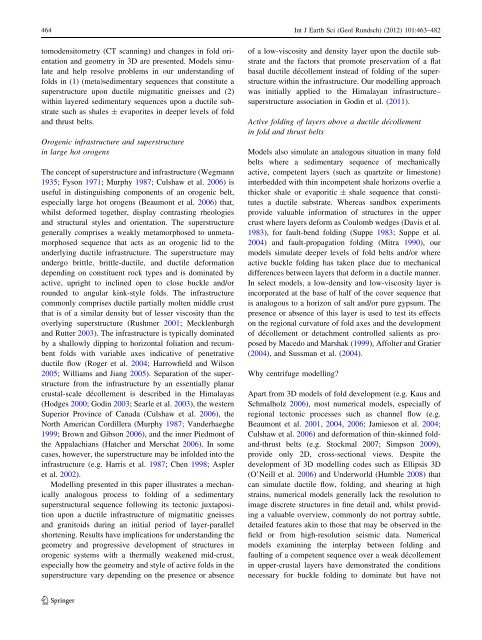Centrifuge modelling of deformation of a multi-layered sequence ...
Centrifuge modelling of deformation of a multi-layered sequence ...
Centrifuge modelling of deformation of a multi-layered sequence ...
Create successful ePaper yourself
Turn your PDF publications into a flip-book with our unique Google optimized e-Paper software.
464 Int J Earth Sci (Geol Rundsch) (2012) 101:463–482tomodensitometry (CT scanning) and changes in fold orientationand geometry in 3D are presented. Models simulateand help resolve problems in our understanding <strong>of</strong>folds in (1) (meta)sedimentary <strong>sequence</strong>s that constitute asuperstructure upon ductile migmatitic gneisses and (2)within <strong>layered</strong> sedimentary <strong>sequence</strong>s upon a ductile substratesuch as shales ± evaporites in deeper levels <strong>of</strong> foldand thrust belts.Orogenic infrastructure and superstructurein large hot orogensThe concept <strong>of</strong> superstructure and infrastructure (Wegmann1935; Fyson 1971; Murphy 1987; Culshaw et al. 2006) isuseful in distinguishing components <strong>of</strong> an orogenic belt,especially large hot orogens (Beaumont et al. 2006) that,whilst deformed together, display contrasting rheologiesand structural styles and orientation. The superstructuregenerally comprises a weakly metamorphosed to unmetamorphosed<strong>sequence</strong> that acts as an orogenic lid to theunderlying ductile infrastructure. The superstructure mayundergo brittle, brittle-ductile, and ductile <strong>deformation</strong>depending on constituent rock types and is dominated byactive, upright to inclined open to close buckle and/orrounded to angular kink-style folds. The infrastructurecommonly comprises ductile partially molten middle crustthat is <strong>of</strong> a similar density but <strong>of</strong> lesser viscosity than theoverlying superstructure (Rushmer 2001; Mecklenburghand Rutter 2003). The infrastructure is typically dominatedby a shallowly dipping to horizontal foliation and recumbentfolds with variable axes indicative <strong>of</strong> penetrativeductile flow (Roger et al. 2004; Harrowfield and Wilson2005; Williams and Jiang 2005). Separation <strong>of</strong> the superstructurefrom the infrastructure by an essentially planarcrustal-scale décollement is described in the Himalayas(Hodges 2000; Godin 2003; Searle et al. 2003), the westernSuperior Province <strong>of</strong> Canada (Culshaw et al. 2006), theNorth American Cordillera (Murphy 1987; Vanderhaeghe1999; Brown and Gibson 2006), and the inner Piedmont <strong>of</strong>the Appalachians (Hatcher and Merschat 2006). In somecases, however, the superstructure may be infolded into theinfrastructure (e.g. Harris et al. 1987; Chen 1998; Aspleret al. 2002).Modelling presented in this paper illustrates a mechanicallyanalogous process to folding <strong>of</strong> a sedimentarysuperstructural <strong>sequence</strong> following its tectonic juxtapositionupon a ductile infrastructure <strong>of</strong> migmatitic gneissesand granitoids during an initial period <strong>of</strong> layer-parallelshortening. Results have implications for understanding thegeometry and progressive development <strong>of</strong> structures inorogenic systems with a thermally weakened mid-crust,especially how the geometry and style <strong>of</strong> active folds in thesuperstructure vary depending on the presence or absence<strong>of</strong> a low-viscosity and density layer upon the ductile substrateand the factors that promote preservation <strong>of</strong> a flatbasal ductile décollement instead <strong>of</strong> folding <strong>of</strong> the superstructurewithin the infrastructure. Our <strong>modelling</strong> approachwas initially applied to the Himalayan infrastructure–superstructure association in Godin et al. (2011).Active folding <strong>of</strong> layers above a ductile décollementin fold and thrust beltsModels also simulate an analogous situation in many foldbelts where a sedimentary <strong>sequence</strong> <strong>of</strong> mechanicallyactive, competent layers (such as quartzite or limestone)interbedded with thin incompetent shale horizons overlie athicker shale or evaporitic ± shale <strong>sequence</strong> that constitutesa ductile substrate. Whereas sandbox experimentsprovide valuable information <strong>of</strong> structures in the uppercrust where layers deform as Coulomb wedges (Davis et al.1983), for fault-bend folding (Suppe 1983; Suppe et al.2004) and fault-propagation folding (Mitra 1990), ourmodels simulate deeper levels <strong>of</strong> fold belts and/or whereactive buckle folding has taken place due to mechanicaldifferences between layers that deform in a ductile manner.In select models, a low-density and low-viscosity layer isincorporated at the base <strong>of</strong> half <strong>of</strong> the cover <strong>sequence</strong> thatis analogous to a horizon <strong>of</strong> salt and/or pure gypsum. Thepresence or absence <strong>of</strong> this layer is used to test its effectson the regional curvature <strong>of</strong> fold axes and the development<strong>of</strong> décollement or detachment controlled salients as proposedby Macedo and Marshak (1999), Affolter and Gratier(2004), and Sussman et al. (2004).Why centrifuge <strong>modelling</strong>?Apart from 3D models <strong>of</strong> fold development (e.g. Kaus andSchmalholz 2006), most numerical models, especially <strong>of</strong>regional tectonic processes such as channel flow (e.g.Beaumont et al. 2001, 2004, 2006; Jamieson et al. 2004;Culshaw et al. 2006) and <strong>deformation</strong> <strong>of</strong> thin-skinned foldand-thrustbelts (e.g. Stockmal 2007; Simpson 2009),provide only 2D, cross-sectional views. Despite thedevelopment <strong>of</strong> 3D <strong>modelling</strong> codes such as Ellipsis 3D(O’Neill et al. 2006) and Underworld (Humble 2008) thatcan simulate ductile flow, folding, and shearing at highstrains, numerical models generally lack the resolution toimage discrete structures in fine detail and, whilst providinga valuable overview, commonly do not portray subtle,detailed features akin to those that may be observed in thefield or from high-resolution seismic data. Numericalmodels examining the interplay between folding andfaulting <strong>of</strong> a competent <strong>sequence</strong> over a weak décollementin upper-crustal layers have demonstrated the conditionsnecessary for buckle folding to dominate but have not123
















